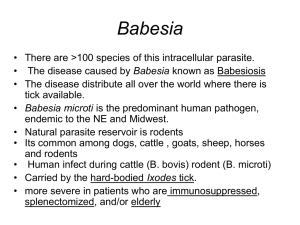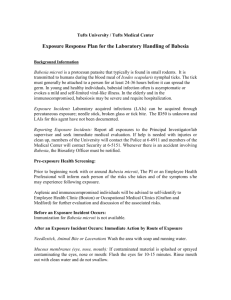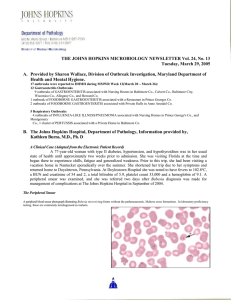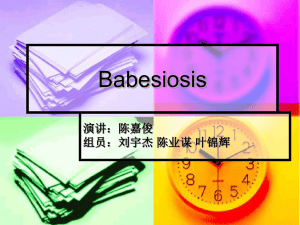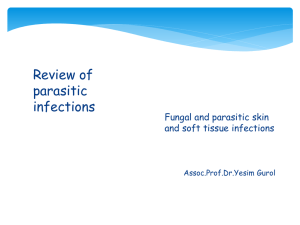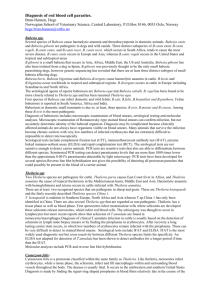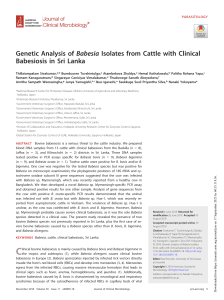Handbook, Babesia reporting criteria
advertisement
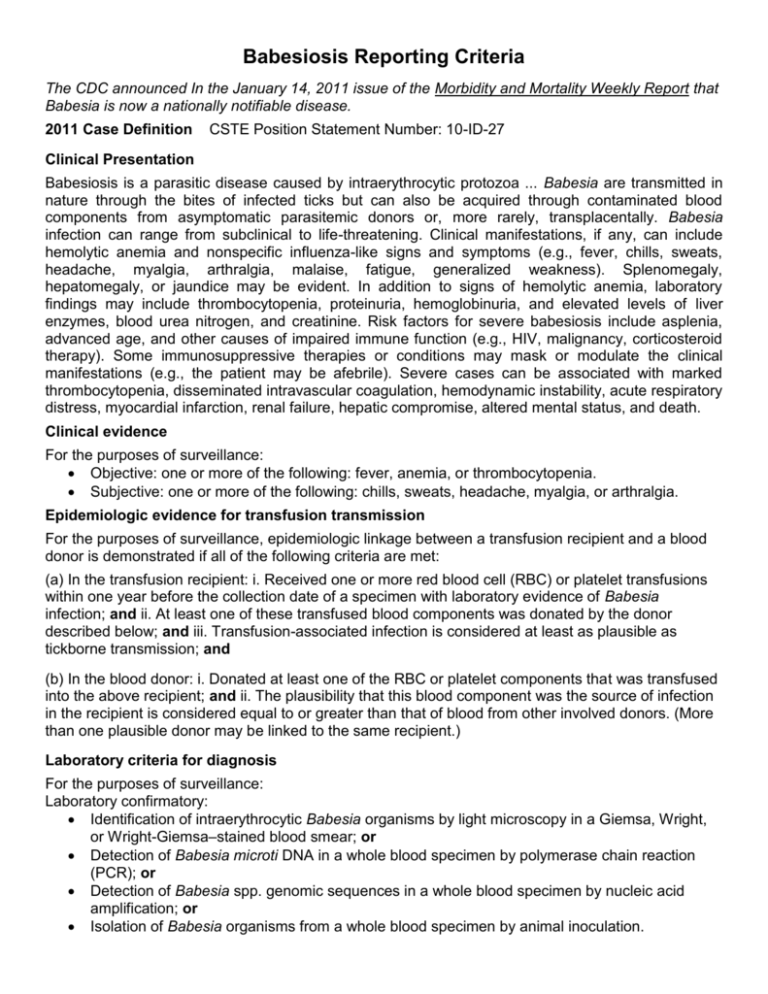
Babesiosis Reporting Criteria The CDC announced In the January 14, 2011 issue of the Morbidity and Mortality Weekly Report that Babesia is now a nationally notifiable disease. 2011 Case Definition CSTE Position Statement Number: 10-ID-27 Clinical Presentation Babesiosis is a parasitic disease caused by intraerythrocytic protozoa ... Babesia are transmitted in nature through the bites of infected ticks but can also be acquired through contaminated blood components from asymptomatic parasitemic donors or, more rarely, transplacentally. Babesia infection can range from subclinical to life-threatening. Clinical manifestations, if any, can include hemolytic anemia and nonspecific influenza-like signs and symptoms (e.g., fever, chills, sweats, headache, myalgia, arthralgia, malaise, fatigue, generalized weakness). Splenomegaly, hepatomegaly, or jaundice may be evident. In addition to signs of hemolytic anemia, laboratory findings may include thrombocytopenia, proteinuria, hemoglobinuria, and elevated levels of liver enzymes, blood urea nitrogen, and creatinine. Risk factors for severe babesiosis include asplenia, advanced age, and other causes of impaired immune function (e.g., HIV, malignancy, corticosteroid therapy). Some immunosuppressive therapies or conditions may mask or modulate the clinical manifestations (e.g., the patient may be afebrile). Severe cases can be associated with marked thrombocytopenia, disseminated intravascular coagulation, hemodynamic instability, acute respiratory distress, myocardial infarction, renal failure, hepatic compromise, altered mental status, and death. Clinical evidence For the purposes of surveillance: Objective: one or more of the following: fever, anemia, or thrombocytopenia. Subjective: one or more of the following: chills, sweats, headache, myalgia, or arthralgia. Epidemiologic evidence for transfusion transmission For the purposes of surveillance, epidemiologic linkage between a transfusion recipient and a blood donor is demonstrated if all of the following criteria are met: (a) In the transfusion recipient: i. Received one or more red blood cell (RBC) or platelet transfusions within one year before the collection date of a specimen with laboratory evidence of Babesia infection; and ii. At least one of these transfused blood components was donated by the donor described below; and iii. Transfusion-associated infection is considered at least as plausible as tickborne transmission; and (b) In the blood donor: i. Donated at least one of the RBC or platelet components that was transfused into the above recipient; and ii. The plausibility that this blood component was the source of infection in the recipient is considered equal to or greater than that of blood from other involved donors. (More than one plausible donor may be linked to the same recipient.) Laboratory criteria for diagnosis For the purposes of surveillance: Laboratory confirmatory: Identification of intraerythrocytic Babesia organisms by light microscopy in a Giemsa, Wright, or Wright-Giemsa–stained blood smear; or Detection of Babesia microti DNA in a whole blood specimen by polymerase chain reaction (PCR); or Detection of Babesia spp. genomic sequences in a whole blood specimen by nucleic acid amplification; or Isolation of Babesia organisms from a whole blood specimen by animal inoculation. Laboratory supportive: Demonstration of a Babesia microti Indirect Fluorescent Antibody (IFA) total immunoglobulin (Ig) or IgG antibody titer of greater than or equal to ( ≥ ) 1:256 (or ≥1:64 in epidemiologically linked blood donors or recipients); or Demonstration of a Babesia microti Immunoblot IgG positive result; or Demonstration of a Babesia divergens IFA total Ig or IgG antibody titer of greater than or equal to ( ≥ ) 1:256; or Demonstration of a Babesia duncani IFA total Ig or IgG antibody titer of greater than or equal to ( ≥ ) 1:512. Case classification Confirmed: A case that has confirmatory laboratory results and meets at least one of the objective or subjective clinical evidence criteria, regardless of the mode of transmission (can include clinically manifest cases in transfusion recipients or blood donors). Probable: (a) a case that has supportive laboratory results and meets at least one of the objective clinical evidence criteria (subjective criteria alone are not sufficient); or (b) a case that is in a blood donor or recipient epidemiologically linked to a confirmed or probable babesiosis case (as defined above) and: i. has confirmatory laboratory evidence but does not meet any objective or subjective clinical evidence criteria; or ii. has supportive laboratory evidence and may or may not meet any subjective clinical evidence criteria but does not meet any objective clinical evidence criteria. Suspected: A case that has confirmatory or supportive laboratory results, but insufficient clinical or epidemiologic information is available for case classification (e.g., only a laboratory report was provided). Comment: The validity of the diagnosis ... is highly dependent on the laboratory ... Confirmation of the diagnosis ... by a reference laboratory is strongly encouraged. ... If the IgM result is positive but the IgG result is negative, a follow-up blood specimen drawn at least one week after the first should be tested. ... In persons who are immunosuppressed or who have asymptomatic Babesia infections, active infections can be associated with lower titers. ... Babesia microti is the most frequently identified agent of human babesiosis in the United States; most reported tick-borne cases have been acquired in parts of northeastern and north-central regions. Sporadic U.S. cases caused by other Babesia agents include B. duncani (formerly the WA1 parasite) and related organisms (CA1-type parasites) in several western states as well as parasites characterized as "B. divergens like" (MO1 and others) in various states. Serologic and molecular tests available for B. microti infection do not typically detect these other Babesia agents. [A note from Kathy White: There is no test for the MO1 strain, which was first discovered in Missouri and may be a prevalent strain in the central states. Therefore, many cases in this area may not meet reporting criteria, which can lead to the illusion that babesia is not here. Many members of the Lyme Association of Greater Kansas City contracted babesia along with Lyme disease. Many have tested positive for Babesia duncani. Most do not have Babesia microti. Many have MO1 or a different strain and may test positive for a protozoan infection on the Eosinophil Cationic Protein (ECP) test at Quest Diagnostics.]
